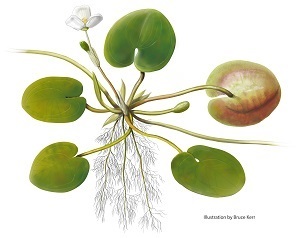|
June 22, 2021
Contact: Joanne Foreman (DNR), 517-284-5814 or Erica Clites (Oakland County CISMA), 248-660-0716
Oakland County CISMA offers free invasive species surveys in ponds and wetlands
European frog-bit, an invasive aquatic plant, has been found in 17 stormwater ponds, wetlands and drains in the Novi area. While the plant is established along Michigan’s east coast, it has only been found in a small number of inland bodies of water, making this Oakland County detection a significant discovery.

The plant, which resembles miniature water lilies, can be moved from one body of water to another when its small seeds or plant fragments attach to wildlife, boats or recreational gear. To prevent widespread infestation, it is important to identify and manage infested areas.
Invasive species are those that are not native and can cause harm to the environment, economy or human health.
|
Free surveys offered in Novi area
The Oakland County Cooperative Invasive Species Management Area is leading European frog-bit management efforts in the Novi area and is seeking permission from people to survey waters on their properties.

“We are hoping to reach homeowner associations, businesses and individual residents with ponds, detention basins or wetlands on their properties,” said Erica Clites, Oakland County CISMA director. “The survey focuses on the plants in the water and usually takes about 15 to 45 minutes.”
Through support from the Michigan Invasive Species Grant Program, these surveys are free to landowners in the project area, which includes Farmington, Farmington Hills, Lyon Township, Novi, South Lyon, Walled Lake, Wixom, Wolverine Lake, and parts of Commerce, Milford and West Bloomfield townships.
Anyone interested in arranging a survey can contact Emily Messick at EMessick@sixriversrlc.org or 248-660-0240. Teams from Friends of the Rouge and the Huron River Watershed Council will conduct the surveys.
|
What if European frog-bit is found on my property?
If survey teams find European frog-bit, property owners will not be required to take any additional steps; however, funds may be available for treatment through the Oakland County CISMA.
“If there are just a few plants, crews can remove them by hand, but if there is a large infestation, chemical weed treatment may be suggested,” said Clites. “No matter which treatment is recommended, annual follow-up is needed to check for regrowth.”
What is European frog-bit?

A native of Europe and parts of Africa and Asia, European frog-bit is an aquatic plant with small (half-inch to 2.5-inch), heart-shaped leaves that look like miniature water lilies. Unlike similar aquatic plants, European frog-bit does not anchor its roots in the lake or stream bed and is free-floating. Three-petaled white flowers with yellow centers appear briefly between June and July.
|
Why is it a problem?
The plant quickly forms dense colonies or mats in shallow, slow-moving waters. These mats can alter food and habitat for ducks and fish and cause problems for boaters, anglers and swimmers.
Virtual public meeting scheduled
The Oakland County CISMA has scheduled a public meeting on Zoom at 7 p.m. Wednesday, July 14, to discuss its European frog-bit program and answer questions. Those interested in attending should register using the link at OaklandInvasiveSpecies.org/Frogbit-Project or visit the Oakland County CISMA’s Facebook event page.
To find out more about European frog-bit, visit Michigan.gov/Invasives or OaklandInvasiveSpecies.org.
Michigan's Invasive Species Program is cooperatively implemented by the Department of Environment, Great Lakes, and Energy, the Department of Natural Resources and the Department of Agriculture and Rural Development.
/Note to editors: Accompanying photos are available below for download. Suggested caption information follows.
Flowers: European frog-bit can form dense mats of vegetation on the water’s surface, making swimming, boating and fishing a challenge.
Map: The Oakland County CISMA’s European frog-bit project area, outlined in red, covers most of the southwest corner of Oakland County.
Plant: European frog-bit resembles small water lilies, with round to heart-shaped leaves and white blossoms with yellow centers visible in June and July./
|